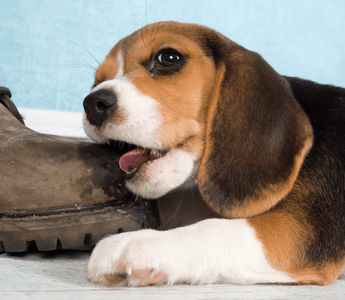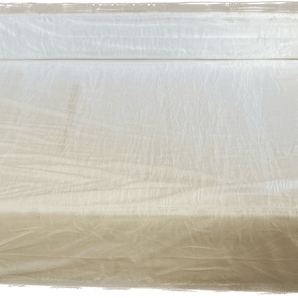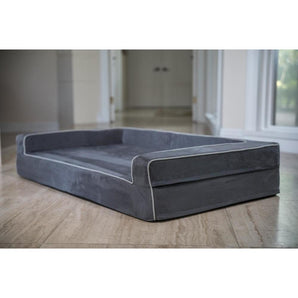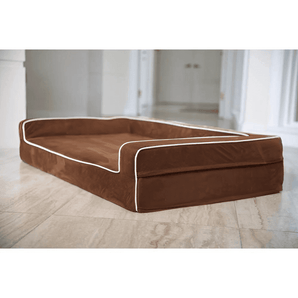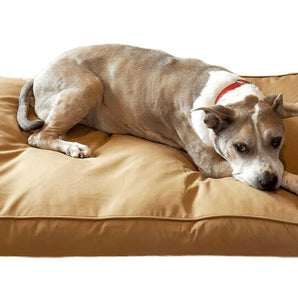Puppies are precious. Something about their sweet puppy breath and their giant puppy paws just makes you fall in love at first sight. But then you bring them home and all of a sudden, everything you own becomes a chew toy—nothing is off limits.
Every new puppy owner has asked themselves the question, "When do puppies stop chewing?" as they survey the aftermath of yet another chewed-up shoe or couch corner. It's a phase that can test the patience of even the most loving pet parents, leading many to seek out advice and solutions to preserve their belongings and ensure their furry friend's safety.
If you're worried about chewed shoes and gnawed furniture, fear not. We'll share some practical advice and strategies for managing and redirecting your puppy's chewing behavior. Read on to learn how to turn this challenging phase into a valuable bonding and behavioral training opportunity.
When Do Puppies Stop Chewing on Things?
Just like not all human babies follow the same developmental timelines, neither do puppies. They all develop at different rates, and their temperament, personality, and your dedication to training will all play a factor in when they'll stop turning everything into a chew toy.
In general, puppies start to ease off their destructive chewing behavior around six months to a year of age, as they lose their baby teeth and their adult teeth fully come in. The exact timeframe can vary widely among individual dogs and is influenced by factors such as breed, size, and whether appropriate chew toys and training are provided.
Why Do Puppies Engage in Destructive Chewing?
One of the first steps to stop puppy chewing is figuring out the root cause of the behavior. There are a number of reasons you may come home to find your pup gnawing on your favorite book or the table legs:
Teething Discomfort and Relief
As puppies grow, their baby teeth start to fall out to make way for the adult teeth, a process known as teething. This teething phase can be uncomfortable for them, leading to pain and irritation in their gums. To alleviate the discomfort, dogs chew on objects to soothe their sore gums. This natural behavior is similar to how a toddler uses a teething ring to alleviate teething discomfort.
Quick tip: Give your puppy safe chew toys specifically designed for the teething phase.
Boredom and Lack of Exercise
Young dogs have seemingly endless energy, and they're always ready to bounce around and play. When they feel bored or aren't physically or mentally stimulated, they'l look for ways to entertain themselves. This often involves exploring their surroundings and may lead to them engaging in one of their favorite dog sports: chewing on everything they can find.
Quick tip: If you're going to need to leave your dog in a confined space like a crate for an extended period of time, take them on a long walk or have some playtime first to wear them out.
Seeking Attention or Stress Relief
Similar to humans, puppies can experience stress and anxiety in various situations. Chewing acts as a means for them to manage these emotions; it's a subtle way for them to seek attention, almost like a non-verbal cue that says, "Look at me and pay attention to me."
Quick tip: Puppies need attention and interaction just like human babies do; try getting your dog their own toys and engaging in a few minutes of playtime with them each day.
Separation Anxiety
Leaving a puppy alone at home can be tough on them. They may resort to chewing things as a coping mechanism for their anxiety. It's their way of expressing their emotions and longing for your presence by saying, "I miss you." This behavior often stems from their natural instincts and the need for comfort and reassurance.
Quick tip: If your puppy suffers from separation anxiety, try giving them some edible chews specifically made for dogs with anxiety, like these K9 Calm Anxiety Chews for Dogs.

Strategies to Prevent and Manage Puppy Chewing
Puppy-Proof Your Home
Take some time to puppy proof your home, or at least the areas your dog will be exposed to. You don't need to go into full-on remodel mode; there are some quick and easy things you can do to remove temptations and make your home a chew-free zone:
-
Make it a habit to tidy up and keep items off the floor. Put shoes in a shoe closet, toys in a toy bin, and keep snacks and food out of reach.
-
Unplug electrical cords that aren't in use, or string them through cord concealers to keep your puppy from chewing on them.
-
Keep interior doors closed in rooms you don't frequent often, or put up a baby gate to block areas you don't want your pup exploring.
Puppy-Proof THEIR Space, Too
When you bring your new puppy home, they should have a space to call their own. Whether it's a crate or a dog bed, they need a space that feels safe and familiar. A dedicated space where they can rest and keep their favorite toys provides a place for your pup to retreat when they're feeling tired, anxious, or just want to relax.
For puppies, a chew proof dog bed can be a game changer. Designed for fierce chewers, they're made with comfortable yet extremely durable material, so even if your dog does start chewing on their bed instead of their toy, the sturdy material and heavy-duty velcro closures will keep it from getting ruined.
Provide Appropriate Chew Toys
Rather than keeping your puppy from chewing on ANYTHING, offer them replacement options that are okay to chew on. Providing appropriate toys allows them to satisfy their natural urge to chew and can relieve pain during the teething stage. Offer a variety of toys to see what your puppy prefers, such as a rope toy, chew bones, teething sticks, or even ice cubes (some dogs LOVE them).
Make sure to always choose safe, durable toys so that when your puppy chews on something you know it's safe and won't become a choking hazard.
Supervise and Correct Inappropriate Chewing
Like any behavior modification, teaching your dog not to chew takes time and reinforcement. When you notice your puppy chewing on something they shouldn't, trade it for an appropriate chew toy. Use a firm "no" when needed, and make sure everyone in the household is onboard with training. Dogs thrive on structure and routine, and they're much more likely to pick up on a command if you and everyone in the household are consistent in reinforcing it.
Keep Your Puppy Mentally and Physically Stimulated
Boredom can often lead to destructive behavior in puppies. To prevent this, make sure your puppy gets enough physical exercise and mental stimulation each day. Take them on walks, play games like fetch or hide-and-seek, and provide them with an appropriate toy to challenge their minds. This will keep them entertained, tire them out, and stop puppy chewing.

Positive Reinforcement Training Techniques
When it comes to training, positive reinforcement is the most effective way to change behaviors in your dog. Here are some tips for using positive reinforcement for training any dog, whether it's a brand new puppy or an adult dog you've recently adopted. (Yes, even an older dog can benefit from positive reinforcement training!)
-
Reward-Based Training for Desired Behaviors: Catch them doing good and offer a reward immediately. Training treats, verbal praise, or a favorite toy are all appropriate ways to reward positive behavior and encourage your pet to repeat that behavior.
-
Clicker Training for Redirecting Behavior: A clicker can be a powerful tool in puppy training. Clicker training helps a dog associate a sound (a click) with an intended behavior and subsequent reward. This method relies on operant conditioning to help your dog learn to modify their behavior based on the action that follows the behavior.
-
Ignoring Unwanted Behaviors: Sometimes, ignoring a negative behavior can be just as powerful as reinforcing a positive one. Attention—whether positive or negative—can reinforce actions. If your puppy chews something off-limits, don't react. Instead, redirect quietly and then reward them when they make the right choice.
-
Consistency and Patience: Training takes time, and no matter which techniques you choose, consistency is key. Repeat lessons as needed and continue to celebrate small victories. If your dog begins to regress, don't panic. Go back to the basics until they've got it down and then move forward in the training process.
How to Incorporate the Bully Beds Chew Proof Dog Bed into Your Dog's Training Routine
When introducing a new training tool such as a chew proof dog bed into your dog's training routine, follow the tips below:
-
Introduce the bed: Start by placing the bed in a cozy spot your dog is already familiar with. If they're used to sleeping in a bedroom with humans, try placing it on the floor next to your bed. Use treats, toys, or your dog's favorite blanket to make it an appealing spot. Help your puppy associate their new bed with rewards, not punishment.
-
Reinforcing Positive Behavior: When you see your dog using their new bed, reward them with a treat, praise, and love so they know it's a place they're encouraged to use. If you notice your dog chewing on his bed, offer a chew toy instead. Then, reward the switch when he transitions to chewing on the toy.
-
Monitor and Adjust as Needed: Keep an eye on your dog and supervise their early interactions with the bed. This helps ensure the bed is used for snoozing, not chewing. Stay consistent with your training and rewards, and if the problem problems persist, don't hesitate to seek advice from a pro such as your veterinarian or a dog trainer.

Help Your Puppy Learn to Stop Chewing
So, when do puppies stop chewing? The answer depends on the dog as well as your dedication to training. The chewing phase typically diminishes by the year mark; as puppies eventually become adult dogs. However, it's crucial to note that some dogs may continue the habit until adulthood, especially if training is inconsistent.
To tackle puppy chewing, be consistent, be patient, and choose the right support products, such as puppy chew toys and the Bully Bed's Chew-Proof Dog Bed. This bed, built to withstand dog chewing and provide orthopedic support, can be a great training tool. It acts as a cozy spot for your puppy to relax and deters household item destruction.
Finally, remember to reward your puppy for using their bed or appropriate dog toys instead of forbidden items to reinforce good behavior. Consistent training and mental and physical stimulation as your puppy grows will prevent destructive chewing.
